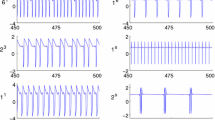Abstract
A general set of ideas related to the modeling of memristors is presented. The memristor is considered as a partially ordered physicochemical system, located in terms of nonlinear dynamics within the “edge of chaos.” The logical-historical relationship of the physics of memristors, nonlinear dynamics, and neuromorphic systems is illustrated in the form of a diagram. Nonlinearity is divided by us into external nonlinearity, when the behavior of an electric circuit containing a memristor is described, and internal nonlinearity, due to processes in the filament volume. In the simulation modeling, attention is drawn to the connectionist approach, well known in the theory of neural networks, but applicable to describe the evolution of a filament as the dynamics of a network of traps connected electrically and quantum mechanically. The state of each trap is discrete and it is called an oscillator. The applied value of the theory of lattices of coupled oscillators is indicated. The flow of high-density current through the filament can lead to the necessity of taking into account both discrete processes (trap generation) and continuous processes (introducing elements of the solid-state band theory into the model). Nevertheless, a compact model is further developed in which the state of such a network is aggregated up to three phase variables: filament length, its total charge, and the local temperature. Despite the apparent physical meaning, all variables have a formal character, usually inherent in the parameters of compact models. The model consists of one algebraic equation, two differential equations, and one integral constraint equation, and it is inherited from the simplest Strukov model. Therefore, it uses the window function approach. It is indicated that, according to the Poincaré–Bendixson theorem, this is sufficient to explain the instability of the four key parameters (switching voltages and resistances) during memristor cycling. The Fourier spectra of the time series of these parameters are analyzed on a small sample of experimental data. The data refer to the structure of TiN/HfOx/Pt (0 < x < 2). The preliminary conclusion on the predominance of low frequencies and the stochastic appearance of frequencies requires further verification.







Similar content being viewed by others
REFERENCES
Tarkov, M.S., Implementation of a neural WTA network on a memristor crossbar, Prikl. Diskret. Mat., Prilozh., 2015, no. 8.
Wang, Z., Wu, H., Burr, G.W., et al., Resistive switching materials for information processing, Nat. Rev. Mater., 2020. https://doi.org/10.1038/s41578-019-0159-3
Meiran Zhao et al., Reliability of analog resistive switching memory for neuromorphic computing, Appl. Phys. Rev., 2020, no. 7, p. 011301. https://doi.org/10.1063/1.5124915
Benderli, S. and Wey, T.A., On spice macromodeling of TiO2 memristors, Electron. Lett., 2009, vol. 45, no. 7, pp. 377–379.
Pickett, M.D. et al., Switching dynamics in titanium dioxide memristive devices, J. Appl. Phys., 2009, vol. 106, no. 7, p. 074508.
Yakopcic, C. et al., A memristor device model, IEEE Electron Dev. Lett., 2011, vol. 32, no. 10, pp. 1436–1438.
Chua, L., Memristor. The missing circuit element, IEEE Trans. Circuit Theory, 1971, vol. 18, no. 5, pp. 507–519.
Hui Chang et al., Unstable limit cycles and singular attractors in a two-dimensional memristor-based dynamic system, Entropy, 2019, vol. 21, no. 4, p. 415. https://doi.org/10.3390/e21040415
Mikheev, R., Teplov, G., and Matyushkin, I., Compact model of nonlinear dynamics while the cycling of a memristor, in Proceedings of the 2019 IEEE Conference of Russian Young Researchers in Electrical and Electronic Engineering (IECONRUS), St. Petersburg, Moscow, Russia, 2019, pp. 2057–2061. https://doi.org/10.1109/EIConRus.2019.8657191
Pershin, Y.V. and Slipko, V.A., Dynamical attractors of memristors and their networks, Europhys. Lett., 2019, vol. 125, p. 20002.
Pershin, Y.V. and Slipko, V.A., Bifurcation analysis of a TaO memristor model, arXiv:1906.01377, 2019.
Crutchfield, J.P. and Young, K., Computation at the onset of chaos, in Entropy, Complexity, and the Physics of Information, W. Zurek, Ed., Vol. 8 of SFI Studies in the Sciences of Complexity, Reading, MA: Addison-Wesley, 1990, pp. 223–269.
Csaba, G. and Porod, W., Coupled oscillators for computing: a review and perspective, Appl. Phys. Rev., 2020, vol. 7, p. 011302.
Malagarriga, D. et al., Synchronization-based computation through networks of coupled oscillators, Front. Comput. Neurosci., 2015, vol. 9, p. 97.
Islamov, D.R. et al., Identification of the nature of traps involved in the field cycling of Hf0.5Zr0.5O2-based ferroelectric thin films, Acta Mater., 2019, vol. 166, p. 47–55.
Panda, D., Sahu, P.P., and Tseng, T.Y., A collective study on modeling and simulation of resistive random access memory, Nanoscale Res. Lett., 2018, vol. 13, no. 1, p. 8.
Miritello, G. et al., Central limit behavior in the Kuramoto model at the ‘Edge of Chaos,’ Phys. A (Amsterdam, Neth.), 2009, vol. 388, pp. 4818–4826.
Everhardt, A.S. et al., Periodicity-doubling cascades: direct observation in ferroelastic materials, Phys. Rev. Lett., 2019, vol. 123, p. 087603. https://doi.org/10.1103/PhysRevLett.123.087603
Orlov, O., Murashev, V., Lebedev, A., Orlov, V., and Ivanov, S., Features of the improving of the HFO2 ReRAM cells characteristics reproducibility, in Proceedings of the 2019 IEEE Conference of Russian Young Researchers in Electrical and Electronic Engineering (EIConRus), Jan. 28–31, 2019, pp. 2087–2089. https://doi.org/10.1109/EIConRus.2019.8657230.
Strukov, D.B. et al., The missing memristor found, Nature (London, U.K.), 2008, vol. 453, no. 7191, p. 80.
Kim, S., Compact two-state-variable second-order memristor model, Small, 2016, vol. 12, no. 24, 3320-6. https://doi.org/10.1002/smll.201600088
ACKNOWLEDGMENTS
I would like to thank the employees of AO Research Institute of Molecular Electronics, O.M. Orlov and A.O. Lebedev, for the experimental data on the cycling of hafnium oxide-based memristor structures.
Author information
Authors and Affiliations
Corresponding author
Additional information
The article was prepared based on a report presented at the 1st International Conference on “Mathematical Modeling in Materials Science of Electronic Components,” Moscow, 2019.
Rights and permissions
About this article
Cite this article
Matyushkin, I.V. Nonlinear Dynamic Approach in Analyzing the Instability of Memristor Parameters. Russ Microelectron 49, 554–561 (2020). https://doi.org/10.1134/S1063739720080041
Received:
Revised:
Accepted:
Published:
Issue Date:
DOI: https://doi.org/10.1134/S1063739720080041



